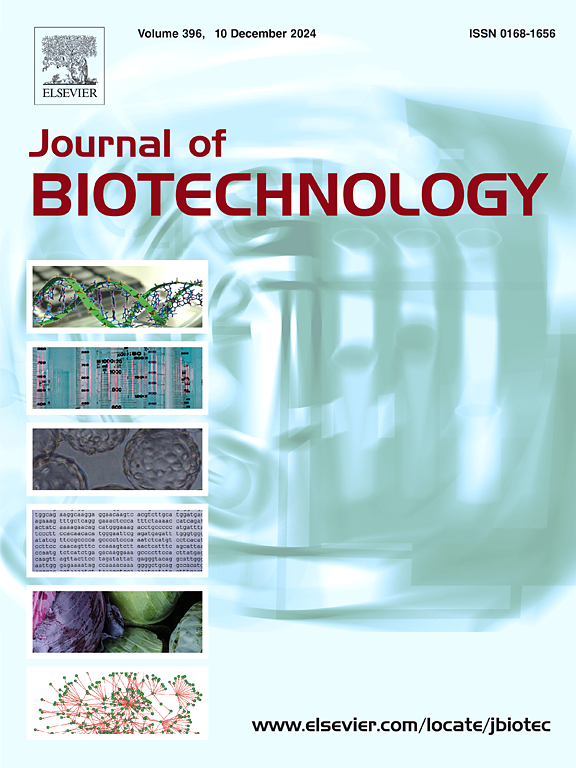Untargeted metabolomics profiling reveals carbon source-dependent rhamnolipid congener production in Burkholderia thailandensis E264
IF 3.9
2区 生物学
Q2 BIOTECHNOLOGY & APPLIED MICROBIOLOGY
引用次数: 0
Abstract
This study investigated glycerol and oleic acid as carbon sources on RL production and congener diversity in Burkholderia thailandensis E264 (BSL 1), a safer alternative to Pseudomonas aeruginosa, using an untargeted metabolomic approach. B. thailandensis E264 was grown in triplicate for nine days at 30 °C, extracted using ethyl acetate, and analysed using LC/Q-TOF/MS. Results showed 84 RL congeners with different adducts were annotated. Cultures with glycerol primarily produced di-RLs with carbon chain lengths from C12:2 to C16-C14, whereas cultures with oleic acid produced mono-RLs (C8:2 to C16-C16). Multivariate analysis of PLS-DA revealed distinct RL profiles in response to different carbon sources, with di-RL-C10-C12 (VIP = 2.15) and mono-RL-C10-C14:1 (VIP = 1.90) identified as key congeners in the glycerol and oleic acid cultures, respectively. The heatmap highlighted significant fold changes in RL congener abundance (2.94-fold higher di-RL-C14 in glycerol culture and 4.38-fold higher mono-RL-C8-C10 in oleic acid culture). These findings demonstrate that the carbon source significantly affects RL congener production in B. thailandensis E264, suggesting the potential for RL production optimisation and tailoring congener profiles for specific applications.
泰国伯克霍尔德菌E264碳源依赖性鼠李糖脂同源物的非靶向代谢组学分析
本研究采用非靶向代谢组学方法研究了甘油和油酸作为碳源对泰国伯克霍尔德菌E264 (BSL 1) RL产生和同源多样性的影响,BSL 1是铜绿假单胞菌更安全的替代品。泰国芽孢杆菌E264在30℃条件下培养3次,培养9 d,乙酸乙酯提取,LC/Q-TOF/MS分析。结果显示,84个RL同源物有不同加合物的注释。甘油培养主要产生碳链长度为C12:2至C16-C14的二链rls,而油酸培养产生单链rls (C8:2至C16-C16)。PLS-DA的多变量分析显示,不同碳源对RL谱的响应不同,甘油和油酸培养的关键同源基因分别为di-RL-C10-C12 (VIP = 2.15)和单RL- c10 - c14:1 (VIP = 1.90)。热图显示了RL同系物丰度的显著变化(甘油培养物中双RL- c14高2.94倍,油酸培养物中单RL- c8 - c10高4.38倍)。这些研究结果表明,碳源显著影响泰国b.t aiandensis E264的RL同系物产量,这表明RL产量优化和为特定应用定制同系物剖面的潜力。
本文章由计算机程序翻译,如有差异,请以英文原文为准。
求助全文
约1分钟内获得全文
求助全文
来源期刊

Journal of biotechnology
工程技术-生物工程与应用微生物
CiteScore
8.90
自引率
2.40%
发文量
190
审稿时长
45 days
期刊介绍:
The Journal of Biotechnology has an open access mirror journal, the Journal of Biotechnology: X, sharing the same aims and scope, editorial team, submission system and rigorous peer review.
The Journal provides a medium for the rapid publication of both full-length articles and short communications on novel and innovative aspects of biotechnology. The Journal will accept papers ranging from genetic or molecular biological positions to those covering biochemical, chemical or bioprocess engineering aspects as well as computer application of new software concepts, provided that in each case the material is directly relevant to biotechnological systems. Papers presenting information of a multidisciplinary nature that would not be suitable for publication in a journal devoted to a single discipline, are particularly welcome.
 求助内容:
求助内容: 应助结果提醒方式:
应助结果提醒方式:


